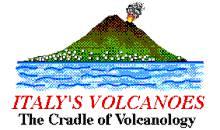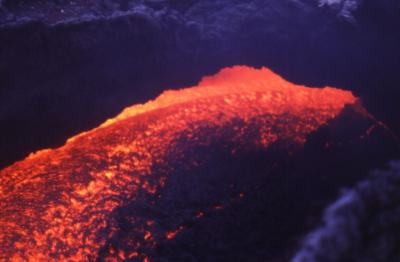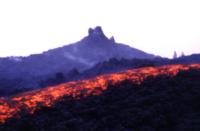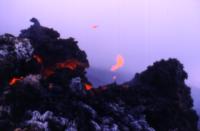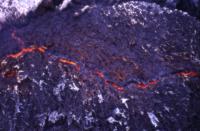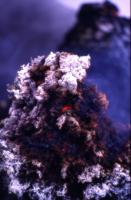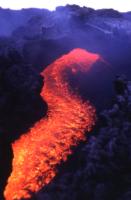|
Archived Etna news
|
Do you plan to visit Etna
in the near future?
Check the weather
forecasts for the Etnean area!
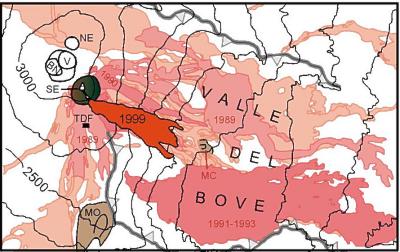
Sketch map of the
Valle del Bove and area of the lava flow-field emplaced since 4 February
1999, situation as of 4 June 1999.
The
lavas erupted during the period 1989-1993 are shown in various shades
of pink, previous flows (since 1971) are shown in brighter color. 1995
to early 1999 lavas are not shown. NE=NE Crater; V=Voragine; BN=Bocca
Nuova; SE=SE Cone; TDF=Torre del Filosofo; MO=Montagnola; RS=Rifugio
Sapienza (only in large version of the map); MC=Monti Centenari. The
large version of this map shows a larger area, a scale bar and an index
map.
Lava flowing into a tube in the central upper part of the lava flow-field formed since 4 February, photographed on 19 June. Flow direction is upwards.
|
WARNING: Access to the summit craters can be DANGEROUS. Weather conditions are often unstable, and there is always a risk of sudden explosive activity from the summit craters. As effusive activity from the fissure near the southeastern base of the SE Cone is gradually decreasing, renewed activity may be expected from the craters soon after the cessation of the lava outflow. Any person who enters the area beyond the Torre del Filosofo mountain hut (2900 m elevation) goes at his/her own risk and is not covered by any insurance in case a rescue operation (e.g., with helicopters) is necessary. The same is true for those who try to get close to the still-active effusive vents on the Valle del Bove slope. |
|
ADDENDUM, 28 JUNE 1999. After a summit visit on 26-27 June, Giuseppe Scarpinati reported the following: The emission of lava from the 4 February fissure continues, and appears to undergo notable fluctuations. Compared to 22 June, there has been a clear increase in the amount of lava emitted (there were at least two major lava flows), and degassing in the upper part of the fissure was stronger, although there was no pyroclastic activity. One fissure-like vent had bunsen burner-like emissions of burning gas, an activity which had occurred frequently at the SE cone during 1997 and 1998 during the long-lived mild Strombolian activity. Scarpinati also noted that there was some significant activity at the Voragine which produced "canon-shot like" explosions. There are unconfirmed reports of explosions from two vents in that crater, and this morning dense gas emissions possibly mixed with ash are well visible from Catania. Geologists from the Dipartimento di Scienze Geologiche of the University of Catania will visit the summit craters during the next days to confirm whether there is a resumption of activity at the Voragine. ADDENDUM, 23 JUNE 1999. There has been a notable decrease in the activity at the 4 February eruptive fissure since the 19 June visit (see report below). Giuseppe Scarpinati who visited the area on 22 June observed only one active flow that issued below the newly formed hornitos; the hornitos themselves were quiet. From Catania, no incandescence was visible when observed with binoculars at nightfall by Boris Behncke. |
Report on the activity observed
on 19 June 1999. The past few days have seen the resumption
of weak explosive activity at the 4 February fissure, and an increase
in the lava output from effusive vents on the same fissure. According
to Giuseppe Scarpinati (Italian delegate of the Association
Volcanologique Européenne, Paris), an intermittent glow in
the eruption area was first visible with the naked eye from Acireale
(southeast of Etna) on the evening of 16 June, indicating minor pyroclastic
ejections. This glow was also clearly visible from Catania on the following
evenings, and lava was seen extending from the area of intermittent
glow.
On the afternoon of 19 June, Boris Behncke, Carmelo Monaco, Betty Giampiccolo,
Daniela Mattina (Dipartimento di Scienze Geologiche, formerly Istituto
di Geologia e Geofisica, of the University of Catania), and Roberto
Scandone (Terza Università of Roma), and others visited the eruption
area. By the time of the visit, one large and several smaller hornitos
had built on top of a large lava shield, about 50-80 m below the cluster
of hornitos built during the first weeks of the activity in February-March
1999. The large hornito (about 3 m high) was the site of rhythmic degassing
at high pressure, at times accompanied by ejections of scoriae which
landed in a radius of 5-10 m around the vent, mostly on the northeastern
side. Minor ejections of scoriae occurred from at least two other sites.
Lava issued from two major and five or six minor vents where strong
degassing also occurred. Hig-pressure gas emission occurred as well
from many cracks in recent lavas near the new hornitos. Two vigorous
lava rivers flowed downslope, one along the northern margin of the lava
field formed since 4 February, the other in its central portion; both
extended a few hundred meters in the direction of the Valle del Bove
but had not yet arrived at its rim (about 500 m southeast of the hornitos).
The central lava flow had developed a channel 3-4 m wide and roofed
over in one or more places, forming spectacular tubes with skylights.
The smaller flows slowly advanced over previous lavas for a few tens
of meters.
The overall impression was that the activity had increased
significantly since Behncke's previous visit on 10 June (see
the 11 June update), and it resembles mucht the early stages of
the current episode of effusive activity initiated on 4 February. At
no moment since late March has the activity been as spectacular as it
is now. This revival of the eruption which since mid-April had shown
a gradual decline probably marks the arrival of a small batch of fresh,
gas-rich magma at the surface. Since late May there had been signs of
increased activity at the summit craters (Bocca Nuova, Voragine, NE
Crater), and apparently this magma has now found its way to the 4 February
fissure. Among the signs of increasing activity had been deep explosions
in the Voragine after 10 June (as reported by the local mountain guides)
and high-pressure gas emission from the active effusive vents where
now the new hornitos have formed, as observed by Giuseppe Scarpinati
on 12 June.
The effusion rate has increased to 2-3 cubic meters per second (it had
been less than or equal to 1 cubic meter per second during the past
month), and the volume of lava emitted since 4 February is exceeding
30 million cubic meters. The latest developments show that although
magma is rising continuously in the central conduit system, this process
is not regular, and consists of batches of magma rising to the surface.
The magma then remains in the central craters where it is degassing,
or drains through fissures like the one in activity since 4 February.
This activity may well continue for weeks or months to come.
visitors counted since 12 February 1999
(more than 10,000 during the first 3 weeks!)
FastCounter
by LinkExchange
Page set up on 27 May 1997, last modified on 28 June 1999
